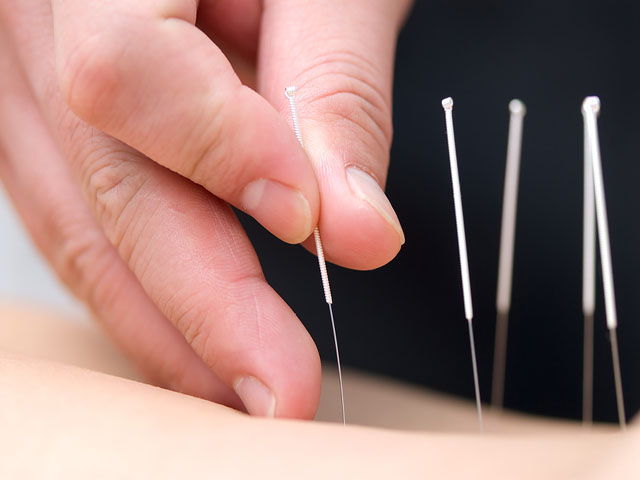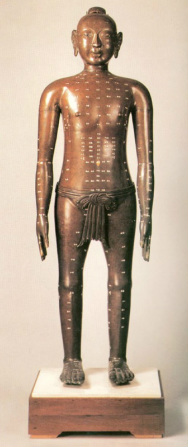Acupuncture

What is acupuncture?
Acupuncture is one of the four pillars of traditional Chinese medicine: Acupuncture, TuiNa, Herbal Medicines and QiGong. Acupuncture is an ancient technique with which a skilled acupuncture physician or practitioner inserts hair-thin needles into specific points on the body to prevent or treat illness. Practiced over 2,500 years in China, where it originated, acupuncture is part of the holistic system of TCM. Since abnormal energy or Qi flows are thought to cause disease, acupuncture aims to restore health by enhancing and/or readjusting the flows of Qi.
While acupuncture was mentioned in Western medical texts more than a hundred years ago (Sir William Osler’s Principles and Practice of Medicine, published in 1892, recommended it for sciatica and lumbago), it wasn’t until 1971 that U.S. citizens really became aware of the technique. It was then that New York Times reporter James Reston, stricken with appendicitis while in Beijing, was treated successfully with acupuncture for post-surgical pain. “I’ve seen the past, and it works!” written by Restonin a front page of Times story.
This exposure came at a time when many Americans were looking for a more holistic, naturalistic approach to health care, and it caused quite a stir among the Western medical community. Since then acupuncture has become a widely accepted form of treatment in the U.S., practiced by MDs and DOs (doctors of osteopathy) who have received special training in its methods, as well as by practitioners who specialize only in the technique.

How does acupuncture work?
According to the principles of TCM, Qi flows through the body via 14 primary meridians or channels. To strengthen the Qi flow, or remove blockages in the meridians, an acupuncturist inserts a number of tiny, sterile, flexible needles just under the skin at certain specific points(acupoints) along the channels. There are thousands of acupoints along the meridians, which are associated with specific internal organs or organ systems. If you are suffering from nausea, for example, needles might be inserted into acupoints on your wrist, while a vision problem might be treated with needles in the foot (Ear, scalp, and hand points are also commonly used by some practitioners). TCM proponents believe that acupuncture stimulates the body’s internal regulatory system and nurtures a natural healing response.
Same as TCM, acupuncture was developed on the basis of experience. There have been trillions of successful cases effective for a score of disorders in the history of acupuncture practice. Although Western science has neither proven nor accepted the notion of Qi, accumulating evidence indicates that acupuncture leads to real physiologic changes in the body. Numerous studies have shown, for
example, that inserting needles into the skin stimulates nerves in the underlying muscles. This stimulation, researchers suggest, sends impulses up the spinal cord to a relatively primitive part of the brain known as the limbic system, as well as to the midbrain and the pituitary gland. Somehow that signaling leads to the release of endorphins and monoamines, chemicals that block pain signals in the spinal cord and brain.
In one study, researchers using brain imaging discovered that acupuncture can alter blood circulation within the brain, increasing the blood flow to the thalamus, the area of the brain that relays pain and other sensory messages. Hundreds of studies are now ongoing in the U.S. and elsewhere seeking to prove the usefulness of acupuncture for various ailments.
Expection and Causion:
On your first visit to an acupuncturist, the practitioner will take a thorough medical history, then may touch pulses on each wrist, examine your tongue, take note of how your breath and body smell, and “palpate” (or feel) certain areas of your body. Depending on your ailment, you may also have your first acupuncture treatment at this time. In general, visits occur once or twice a week over several months until therapeutic results are achieved.
While the needles can feel uncomfortable at times, they rarely hurt. They are very thin (only about three times the thickness of a human hair and much finer than the hypodermic needles used to give injections) and are designed to enter the skin with little resistance. Once the needles are inserted (generally from one to 15 are used), the acupuncturist may twist them manually or send a weak electrical current through them to increase the energy flow. The needles may be left in for 15 to 40 minutes, depending on the ailment. Some practitioners also use moxibustion, which involves burning herbs (primarily the dried herb mugwort), near acupoints, to hasten healing.
Different people experience different sensations from acupuncture. Some describe a tingling pins-and-needles feeling, others may feel numbness or nothing at all. Most find the sessions relaxing, and some fall asleep during or immediately after treatment. Some patients notice rapid improvement after just a few sessions. In those whose conditions have taken years to develop, treatment may take longer.
While scores of illnesses have traditionally been treated by acupuncture in Asia, its primary use in the United States has been to relieve chronic pain caused by such ailments as arthritis, headache, PMS, and back pain, and to assist withdrawal from addictions such as drug and alcohol dependency. Some practitioners also received reasonable good effects for treating a number of chronic internal medical disorders. Now more innovative applications for acupuncture are being explored by both conventional and alternative practitioners, including its use as an analgesic to reduce pain during surgery.
In 1997, an advisory panel for the National Institutes of Health (NIH) evaluated hundreds of acupuncture studies and concluded that the therapy is an effective treatment for postoperative pain after dental surgery and for nausea induced by chemotherapy, pregnancy (“morning sickness”), and anesthesia. The NIH panel also called acupuncture a useful adjunct and acceptable treatment for a variety of conditions, including fibromyalgia, stroke rehabilitation, headache, and carpal tunnel syndrome.
Similar to any other medical treatments, acupuncture may also have side effects. Please be sure to read the patient consent form carefully and do tell your acupuncture physician if you have or have had Hepatitis B and other contagious diseases, or if you are pregnant or think you may be. People on anticoagulant drugs may bleed easily even when thin acupuncture needles are inserted. Consult your primary physician before having acupuncture if you are on such medication.
If you are looking for an experienced acupuncturist, you may contact Dr. Fung, who is a licensed acupuncturist in Kansas City since 2001.
